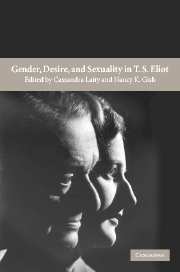Introduction: Eliot, gender, and modernity
Published online by Cambridge University Press: 22 September 2009
Summary
Eliot's female contemporary, poet Kathleen Raine, recalled the impact of her first encounter with Eliot's poetry as “instantaneous and tremendous.” Muriel Bradbrook similarly exclaimed, “the effect of The Waste Land was not gloomy but exhilarating and intensely stimulating … [the poem] gave us a new world … ‘Bliss was it in that dawn to be alive !’” May Sinclair admired Eliot particularly for his “disturbing” “genius.” He is “dangerous,” she remarked, not a poet whom “comfortable and respectable people can see, in the first moment after dinner.” And, as Gail McDonald's study of Eliot's reception by first-generation college women in this volume establishes, his rise in the academy was concurrent with the influx of women into universities, and many saw “their [own] pioneering energies mirrored in his work.” Similarly, with the recent flourishing of queer theory (beginning mainly in the 1990s), gender studies of alternative “masculinities,” and the expansion of feminist criticism into issues of race, class, and male sexuality, contemporary women critics are beginning to echo these early perceptions of Eliot's poetry as startlingly rebellious, “dangerous,” and compelling. Queer theorist Colleen Lamos observes in Deviant Modernism that readers must “fac[e] up to the errant female sexual energies within his … poems if we are to continue to read Eliot with something other than hostility or incomprehension.
- Type
- Chapter
- Information
- Gender, Desire, and Sexuality in T. S. Eliot , pp. 1 - 20Publisher: Cambridge University PressPrint publication year: 2004
- 1
- Cited by



